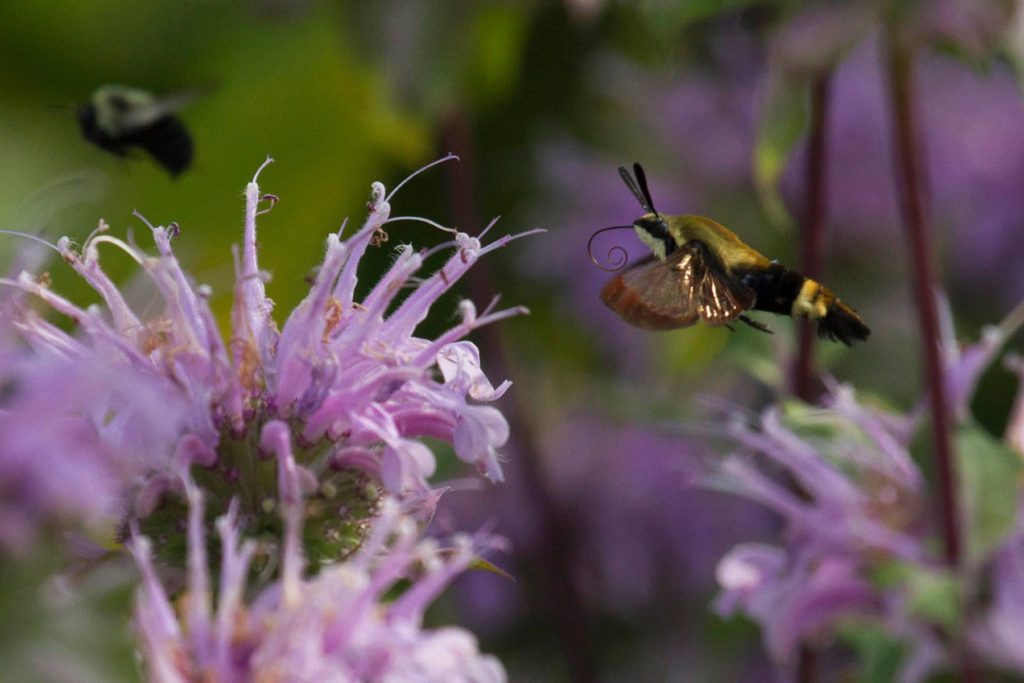 Written by Nancy Nabak, Communication Coordinator
Written by Nancy Nabak, Communication Coordinator
They aren’t normally considered caped heroes, but our pollinators are just that. Heroes. This week is National Pollinator Week and we’re happy to be celebrating our tiny-sized eco-celebrities.
Pollinators, unfortunately, are decreasing in population due to pollution, misuse of chemicals, disease and changing climate patterns. Declines are also happening due to reasons that we fully don’t understand yet, which in itself is cause for great concern. Thankfully, awareness is on the increase and Woodland Dunes is partnering with many like-minded organizations to help spread the word: Manitowoc County Soil and Water Conservation Department, Lakeshore Natural Resource Partnership, US Fish and Wildlife, NRCS, Van der Brohe Arboretum, Harmony Cafe, and a participating family farm. All of us got together this week to offer a pollinator tour to those interested in learning what they can do on a large or small scale to make a difference.
Why are we celebrating insects, bats and hummingbirds – all varieties of pollinators? Because pollination is crucial to our survival. Even refrigerator magnets remind us that one third of the food we are about to eat is pollinated by bees. As much as we may like a juicy steak, a healthy diet for humans still depends on a balance of vegetables, nuts and fruits – compliments of our pollinators. And money talks. Pollination is also crucial to our economy – pollinators produce more than $40 billion dollars worth of products in the US annually. Pollinator plants are also good at producing the oxygen we need to breathe and sequestering carbon dioxide.
But let’s go back to that survival thing. Today it seems that so many things are crucial to our survival – less oil dependence, less violence, and increased healthcare. I don’t think any of these things are disputable, but at the very basic level, we’ve got to give our pollinators a real hard look. And more attention. And for our own sake, help them out. Here are just a few compelling reasons from the USDA:
- Some crops, including blueberries and cherries, are 90 percent dependent on honey bee pollination.
- 90 percent of the nation’s apple crop is pollinated by bees.
- Growers and consumers realize increased yields and higher quality crops from a healthy pollinator population, native or managed.
- Worldwide, approximately 1,000 plants grown for food, beverages, fibers, spices, and medicines need to be pollinated by animals in order to produce the goods on which we depend.
So what can you do?
Consider putting a butterfly garden in your yard or creating a “clump” space where you can plant some native flowers to attract pollinators. Be mindful of soil characteristics, sunlight, and other factors when selecting your plants.
- Provide a variety of flower colors and shapes to attract different pollinators.
- Choose plants that flower at different times of the year to provide nectar and pollen sources throughout the growing season.
- Avoid the use of pesticides. Practice Integrated Pest Management (IPM) to reduce damage to your plants and to protect pollinators by using less chemicals.
- Pollinators, need water too. You can provide water for pollinators with a shallow dish, bowl, or birdbath with half-submerged stones for perches.
- In the fall, leave your dried plant “skeletons” and do not clean them out in the spring until there is a week straight of 50 degree weather to give hibernating pollinators the best chance of survival.
Together, we can make a difference and honor our pollinators in true fashion – bringing them back from a troubled state and celebrating our quality of life because of them.
photo of hummingbird moth on Bergamot by Nancy Nabak
